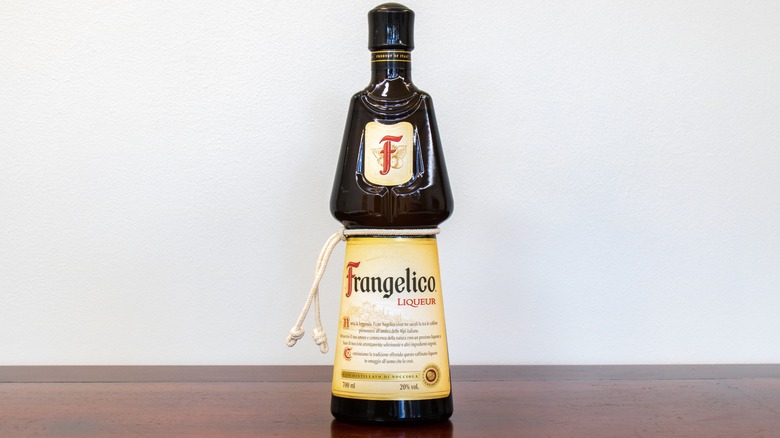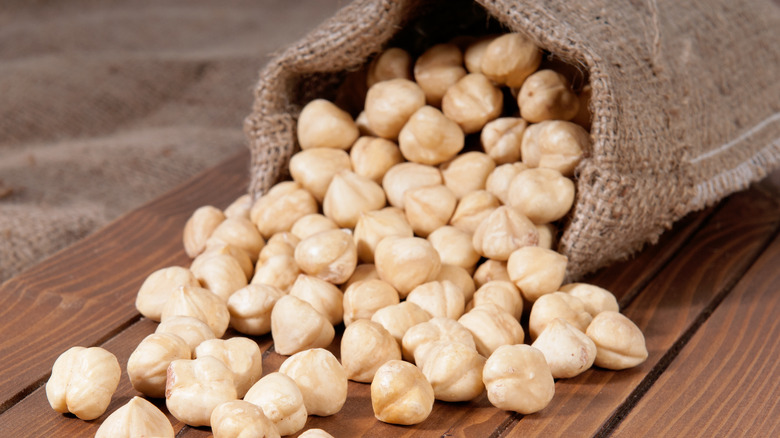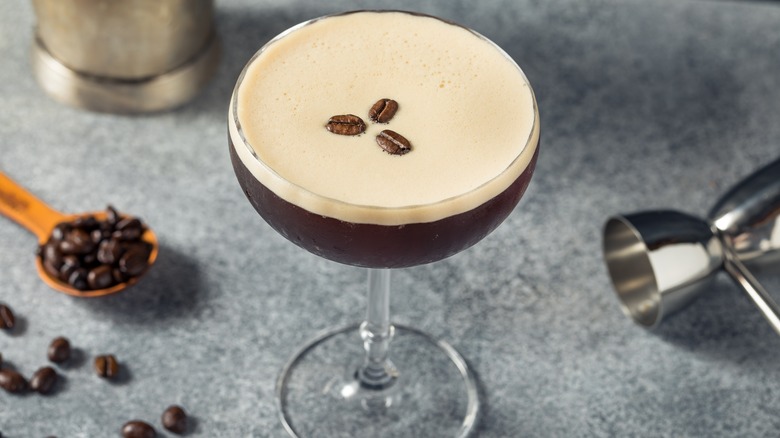The Flavor Profile Of Frangelico And The Best Cocktails To Use It In
Meet Frangelico. Sold in a brown bottle shaped somewhat like Franciscan friars (complete with a rope belt around the middle), it features an ornate label decorated with medieval-style script. It's a hazelnut liqueur that hails from the Piedmont region at the alpine foothills in northern Italy (home to the city of Turin). Supposedly, the drink was created a few hundred years ago by none other than the monks the bottle resembles, using wild hazelnuts from the hills themselves to craft the original brew.
But hazelnuts aren't all there is to Frangelico. While the early stages of producing this beverage involve infusing toasted hazelnuts in alcohol and water before distilling them, there's a mix of other earthy, aromatic flavorings that go into the recipe before it's left to age for around six to eight weeks. These include cocoa, vanilla, and coffee, resulting in a light gold liquid that's about 40-proof in strength (or 20% alcohol). As you might suspect with these ingredients, this is a liqueur that leans sweet and lends itself both to drinking alone, mixing into cocktails, or even with hot drinks like coffee or hot toddies.
So, what does Frangelico taste like?
Unsurprisingly (given the prominence of hazelnuts in the recipe), Frangelico has a distinctly nutty flavor profile, with some earthy overtones, thanks to the rounded coffee and cocoa notes. The inclusion of vanilla means that it could be described as creamy — although not in the literal sense. Unlike, say, Baileys Irish Cream, there's no dairy in Frangelico. Rather, it's that the presence of vanilla is somewhat evocative of creamy tastes and textures — after all, it's a flavor commonly paired with ice cream and other dairy-centric desserts.
Frangelico is certainly sweet, but it's not at a Nutella level of intense sweetness, even if there's some overlap in the flavorings -– it's a liqueur after all, and the not-insubstantial volume of alcohol cancels out some of that sugar. Lastly, while there is coffee in the recipe, it adds more of a subtle flavor hint that blends well with the other tastes -– don't expect a large hit of coffee, as this isn't Kahlua.
It's important to remember that Frangelico is a specific brand: There may be other hazelnut liqueurs on the market with different profiles.
What drinks does Frangelico work with?
Frangelico is traditionally seen as more of a digestif (an after-dinner drink), and for this reason, it's not uncommon to sip it neat or on the rocks. It also works well with coffee — you can either add it directly to regular coffee, or in an Irish coffee-adjacent drink with Frangelico and other liqueurs that loosely fit under the same umbrella, like Kahlua or Baileys. The suggestions on Frangelico's official website follow this path, suggesting a Frangelico affogato (adding the hazelnut booze to the classic espresso-ice cream drink) or a frappé.
If you're looking to work Frangelico into other cocktails, you may want to experiment. It's not an ingredient that features in many classic, well-established, or well-known cocktail recipes like martinis or sours — except for more out-of-the-box variations on these. Perhaps the most obvious "classic" that easily incorporates Frangelico is the espresso martini where Frangelico fits alongside vodka, espresso, and potentially other ingredients like Kahlua or Tia Maria. Frangelico makes a good dupe in place of syrups like orgeat (almond syrup) in cocktails.
Similarly, it could also take the place of amaretto — although amaretto is less sweet, with some bitter notes. Try subbing it into popular amaretto drinks like the amaretto sour, or even an old fashioned. Otherwise, play around with it alongside full-bodied spirits like brandy or whiskey where it generally pairs well — and perhaps surprisingly, it can even pair with tequila in the afterlife cocktail.



